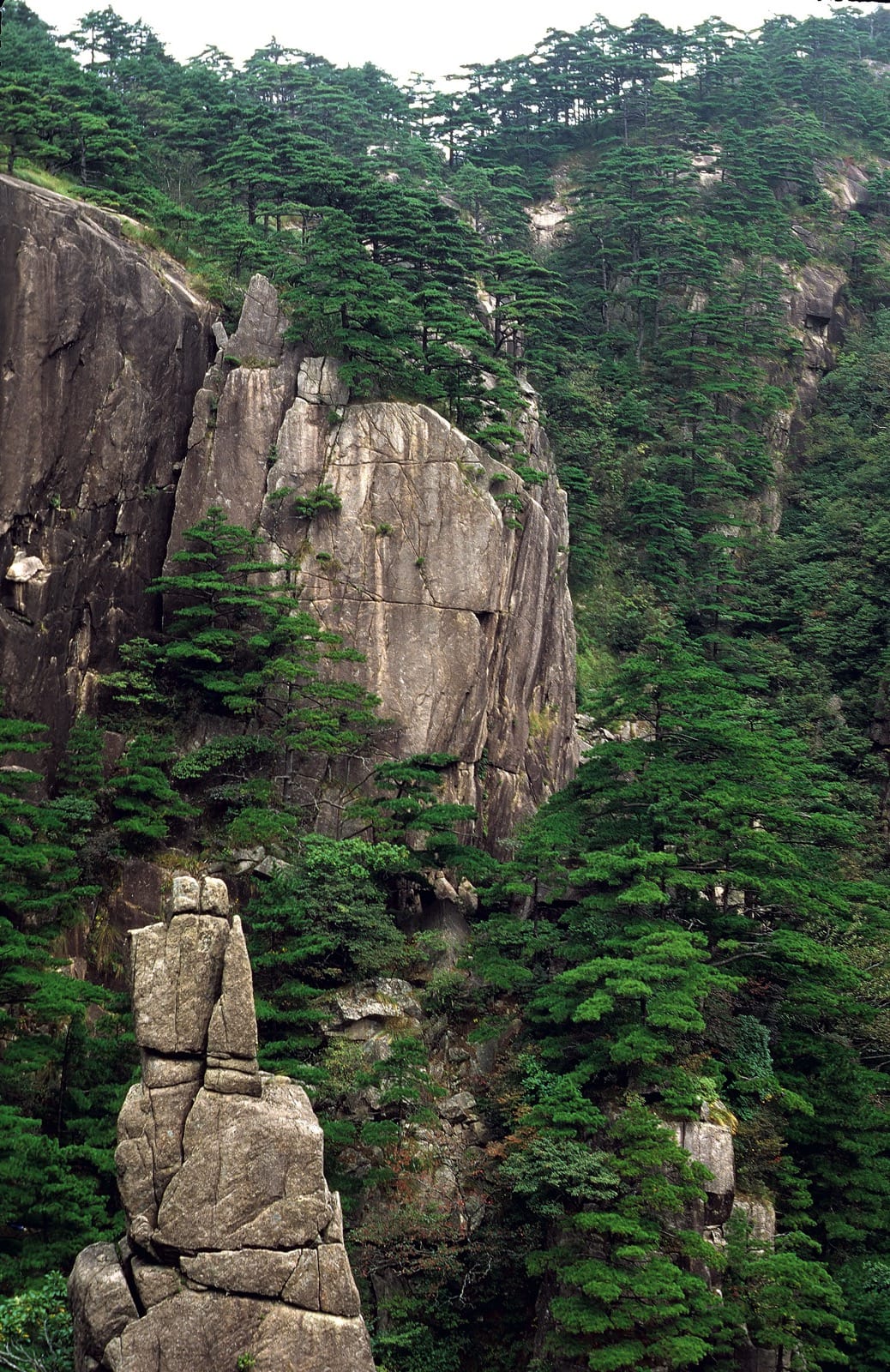Pinus hwangshanensis
Credits
Article from New Trees by John Grimshaw & Ross Bayton
Recommended citation
'Pinus hwangshanensis' from the website Trees and Shrubs Online (treesandshrubsonline.
Genus
- Pinus
- Subgen. Pinus, Sect. Pinus
Common Names
- Huangshan Pine
- Chinese Hard Pine
Other taxa in genus
- Pinus albicaulis
- Pinus arizonica
- Pinus armandii
- Pinus attenuata
- Pinus ayacahuite
- Pinus balfouriana
- Pinus banksiana
- Pinus bhutanica
- Pinus brutia
- Pinus bungeana
- Pinus canariensis
- Pinus cembra
- Pinus cembroides
- Pinus chiapensis
- Pinus contorta
- Pinus coulteri
- Pinus culminicola
- Pinus densata
- Pinus densiflora
- Pinus devoniana
- Pinus durangensis
- Pinus echinata
- Pinus edulis
- Pinus elliottii
- Pinus engelmannii
- Pinus eremitana
- Pinus flexilis
- Pinus gerardiana
- Pinus greggii
- Pinus × hakkodensis
- Pinus halepensis
- Pinus hartwegii
- Pinus heldreichii
- Pinus henryi
- Pinus × holfordiana
- Pinus jeffreyi
- Pinus johannis
- Pinus koraiensis
- Pinus lambertiana
- Pinus leiophylla
- Pinus longaeva
- Pinus massoniana
- Pinus maximartinezii
- Pinus monophylla
- Pinus montezumae
- Pinus monticola
- Pinus morrisonicola
- Pinus mugo
- Pinus muricata
- Pinus nelsonii
- Pinus nigra
- Pinus oocarpa
- Pinus orizabensis
- Pinus palustris
- Pinus parviflora
- Pinus patula
- Pinus peuce
- Pinus pinaster
- Pinus pinceana
- Pinus pinea
- Pinus ponderosa
- Pinus pseudostrobus
- Pinus pumila
- Pinus pungens
- Pinus quadrifolia
- Pinus radiata
- Pinus remota
- Pinus resinosa
- Pinus rigida
- Pinus roxburghii
- Pinus sabiniana
- Pinus serotina
- Pinus sibirica
- Pinus strobiformis
- Pinus strobus
- Pinus sylvestris
- Pinus tabuliformis
- Pinus taeda
- Pinus taiwanensis
- Pinus teocote
- Pinus thunbergii
- Pinus torreyana
- Pinus virginiana
- Pinus wallichiana
- Pinus wangii
- Pinus yunnanensis
Tree to 25 m, trunk straight and to 1 m dbh. Bark scaly, dark grey or purplish grey, developing longitudinal fissures. Crown conical initially, later flat-topped. Branchlets dark brown to chestnut brown, glabrous; vegetative buds slightly resinous. Leaves in fascicles of two, persisting for three to four years, dark green, slender, semicircular in cross-section, 5–12 × 0.08–0.1 cm, margins serrulate, apex acute. Fascicle sheaths 0.5–1 cm long, chestnut brown, persistent. Cataphylls 0.6–0.8 cm, pale brown, early deciduous. Male strobili reddish brown. Female cones subterminal, sessile or short-pedunculate. Cones 3.5–7 × 4–7 cm, yellowish brown, broad-ovoid, maturing in about 18 months, deciduous or persistent, often losing a few basal scales on falling. Scales spreading very wide at maturity, to 90° or even reflexed, 1.8–3 × 0.8–1.4 cm; apophysis rounded, swollen, yellowish brown; umbo dorsal, with a minute, persistent prickle. Seeds dark brown; wings effective, 1.2–1.8 × 0.4–0.6 cm. Li & Keng 1994a, Fu et al. 1999c, Businský 2003. Distribution CHINA: Anhui, Fujian, Henan, Hunan, Jiangxi, Zhejiang. Habitat In open areas and on sunny ridges in warm temperate and montane forests, between 600 and 3400 m asl. USDA Hardiness Zone 7. Conservation status Lower Risk. Illustration NT604. Cross-reference S375. Taxonomic note The taxonomy of P. hwangshanensis is complex. It was treated as a synonym of P. taiwanensis by Fu et al. (1999c), but in the same publication Mill considered that P. taiwanensis was endemic to Taiwan, while all material from the Chinese mainland was referable to P. hwangshanensis. Farjon (2001), however, recognised P. taiwanensis var. damingshanensis W.C. Cheng & L.K. Fu on the Chinese mainland. Li (1997) described P. hwangshanensis and P. taiwanensis as subspecies of the Japanese P. luchuensis, and it is clear that these three taxa form a close group. The most recent account of P. hwangshanensis (Businský 2003) recognises a new subspecies, subsp. transfluminea Businský, from the Dabie Shan Mountains (Anhui, Hubei, Henan), with longer needles (10–16 cm long) and cones (4–8 cm long). This subspecies forms hybrids with P. massoniana on the northwest face of the Miaodoiu Shan Massif.
In its youth Pinus hwangshanensis is a rather unattractive, coarse-needled plant, but in maturity it transforms into one of the most beautiful and picturesque of all pines, forming flat-topped trees with tiers of spreading branches that appear at their best among the rounded rocks of the Huangshan itself in Anhui, giving this World Heritage Site a particular charm (Gymnosperm Database 2006). Named only in 1936, P. hwangshanensis appears to have evaded the attentions of the initial wave of western plant hunters in China, and the details of its first introduction to cultivation are obscure. It was accessioned at the Arnold Arboretum in 1976, at Edinburgh and Wakehurst Place in 1979, and at Kew and the Hillier Gardens in 1980. All these trees were grown from seed supplied by the Chinese Academy of Forestry. It was commercially available in the United Kingdom by 1985, when Charles Howick obtained two specimens from Fyne Trees. The latter are doing well at Howick, both being about 10 m tall when seen in 2005, and the oldest Hillier tree was measured at 11 m in 2007, but as yet none of these show any sign of developing the beautiful flat branches. Grafted plants are still available in the British nursery trade, and it is reasonably well represented in collections in the United Kingdom and in continental Europe. A plant at the US National Arboretum is labelled P. taiwanensis but is from seed collected by Lawrence Lee in the Huang Shan in 1988 and is therefore attributable to P. hwangshanensis; when seen in 2006 this specimen was about 4 m tall and somewhat misshapen, but apparently thriving.

